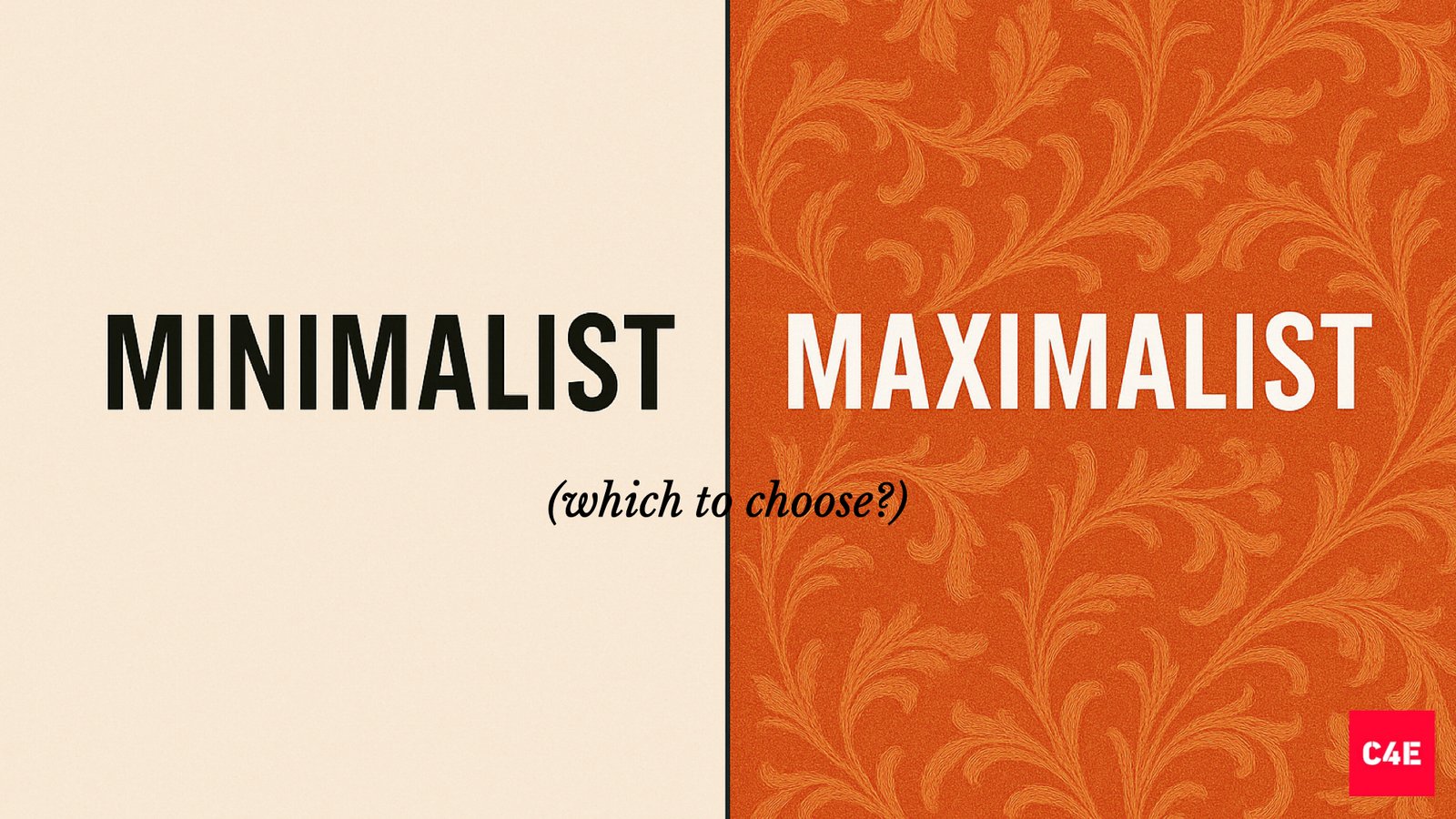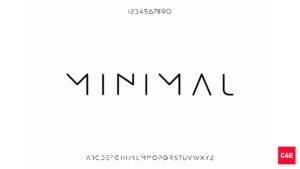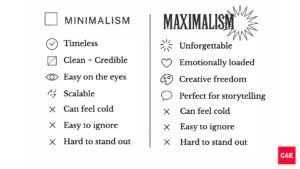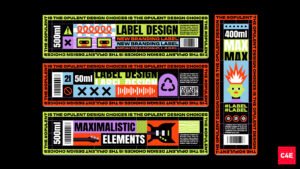
Minimalist vs Maximalist Branding: A No-Fluff Guide
Your brand has five seconds. That’s it.
Five seconds to make someone stop scrolling immediately. Click. Buy. Care. What do they see in those five seconds? Not your product, nope. They see your branding. And if it’s not working, you’ve already lost.
Most brands fail not because they’re “bad” but because they look like everyone else. Too safe. Too loud. Too… forgettable. But what should you choose? Minimalist vs maximalist branding?
They are two opposite ends of the spectrum. One strips away the noise. The other is the noise. White space or wild prints? Clean or chaotic? Timeless or electric?
Which one would make people remember you?
Let’s figure out the best approach for your brand.
Minimalist vs. Maximalist Branding: What’s the Difference Anyway?
Let’s clear the misconceptions right away.
Minimalism doesn’t end at looking clean. Maximalism doesn’t start with going wild. They’re two completely different ways of telling the world who you are.
Minimalism: When Saying Less Says It All
Minimalist branding is restraint with purpose. It’s clean. It’s confident. It says more by doing less.
No clutter, no chaos. Just clarity. Minimalist brand examples include Apple, Google, and Muji. Their branding has white space, simple fonts, one strong message. That’s it. It works because it doesn’t try too hard. And that’s exactly why it stands out.
But simple doesn’t equate to easy. Minimalist branding is brutal precisely because every detail has to be perfect.
Maximalism: The Bold, Loud Branding That Doesn’t Apologize
Maximalist branding kicks the door down. It’s loud, layered, unapologetic. It wants to be felt and not just seen.
Think Gucci, MTV, or Glossier for maximalist design trends. Their branding has bold colors, clashing patterns, words that shout. Maximalist brands start conversations. They take up space: on the shelf, on the screen, and in your head.
If minimalism is a quiet dinner party, maximalism is a rooftop rave.
Pros and Cons: What Each Style Gets Right (and Wrong)
Every style has a payoff. Every style has a price.
Before you pick a side, here’s everything you need to know.
Minimalism: Clean, Timeless, but Is It Enough?
The Wins:
- Timeless: Trends come and go. Minimalist brands stay.
- Clean = Credible: It conveys, “We know what we’re doing.”
- Easy on the eyes: Especially in crowded spaces where everything’s screaming.
- Scalable: Works on billboards, works on business cards.
The Risks:
- Can feel cold: If it’s too stripped down, it stops feeling human.
- Easy to ignore: Especially if your market is full of copycat minimalism.
- Hard to stand out: When everyone’s “clean,” you’re just another plain white box.
Maximalism: Bold, Expressive, but Too Loud?
The Wins:
- Unforgettable: You’ll either love it or hate it. But you won’t forget it.
- Emotionally loaded: It can’t simply exist. It’s meant to hit.
- Creative freedom: You can mix, match, layer, break rules. No limits.
- Perfect for storytelling: Every color, every element says something.
The Risks:
- Can overwhelm: Too much, and people tune out.
- Harder to manage: More elements = more chances to mess it up.
- Not for every audience: Bold can look unprofessional in the wrong setting.
Minimalist vs Maximalist Branding: What the Market Wants
Your brand doesn’t exist in a vacuum but lives in a market. Surrounded by noise, trends, expectations. So it’s natural to wonder: Where does your style actually work?
Minimalist Branding Works When…
You need clarity, authority, trust. Minimalist branding cuts out the noise, which is exactly what some audiences crave.
Industries That Love Minimalism
- Tech: Clean UI, intuitive design, sleek branding. Apple, Notion, Stripe.
- Finance: You don’t want your bank looking like a circus. Wise, PayPal, Amex.
- Healthcare & Wellness: White space = clean space. Headspace, Calm.
- SaaS & B2B: If you’re solving complex problems, your visuals should feel simple, not scary.
Why It Works:
- Gives a sense of control and professionalism.
- Suggests your product speaks for itself. No bells and whistles needed.
- Focuses the user’s attention exactly where you want it.
Maximalist Branding Works When…
You want to grab attention in seconds and keep it.
It’s for brands that want to stand out, challenge the norm, and say something loud.
Industries That Thrive on Maximalism
- Fashion: Luxury prospers on drama. Gucci, Versace, Supreme’s street chaos.
- Beauty & Cosmetics: Think Glossier or Fenty. The colors, the campaigns, the unapologetic energy.
- Entertainment & Music: MTV, Spotify Wrapped, movie posters that slap you in the face.
- Food & Beverage: Especially for youth-targeted products. Bright packaging, wild typography, layered visuals. Poppi, Liquid Death.
Why It Works:
- Emotion sells. Maximalism taps into it instantly.
- More room to tell stories: through color, texture, even excess.
- If your audience wants to express themselves, your brand should do the same.
The 3-Question Test for Picking the Right Style
Forget what’s trendy. Start with these:
1. Who Are You Selling To?
- Do they want clean and functional?
- Or do they want bold, expressive, and visually rich?
Gen Z love maximalism. Corporate buyers will trust a minimalist design before they trust bright pink gradients.
2. What’s Your Brand’s Core Personality?
Minimalist brands say: “We’ve got nothing to prove.”
Simultaneously, maximalist brands convey: “You’ve never seen this before.”
Pick not what looks cool but what feels true.
3. What Are Your Business Goals?
- Want to scale globally and quickly? Simpler might be better.
- Want to disrupt a boring market? Loud branding might be your weapon.
4. Can You Mix Styles?
Yes, if done right.
Some of the best brands pull a hybrid:
- Minimalist structure, maximalist accents.
- Clean layout, bold headlines.
- Simple logo, wild campaign visuals.
Spotify does this masterfully. Their app design is clean. But their campaigns are always explosive.
Remember, at the end of the day, your style should answer one thing: Does this make people care?
The Style You Choose Today Defines Your Brand Tomorrow
Don’t look at this comparison from the perspective of finding which style is “better.”
Success is whatever can make people stop, look, and remember you. Minimalist branding is precise and confident. Maximalist branding is explosive and emotional.
Both can win. Both can fail. The only thing that matters is that your brand shows up with intention.
Because forgettable brands don’t survive, and middle-of-the-road brands get run over. So, how to choose a branding style? One that actually says what your brand needs to say. And then go all in.
Because the brands that win are the ones that dare to look like themselves.




